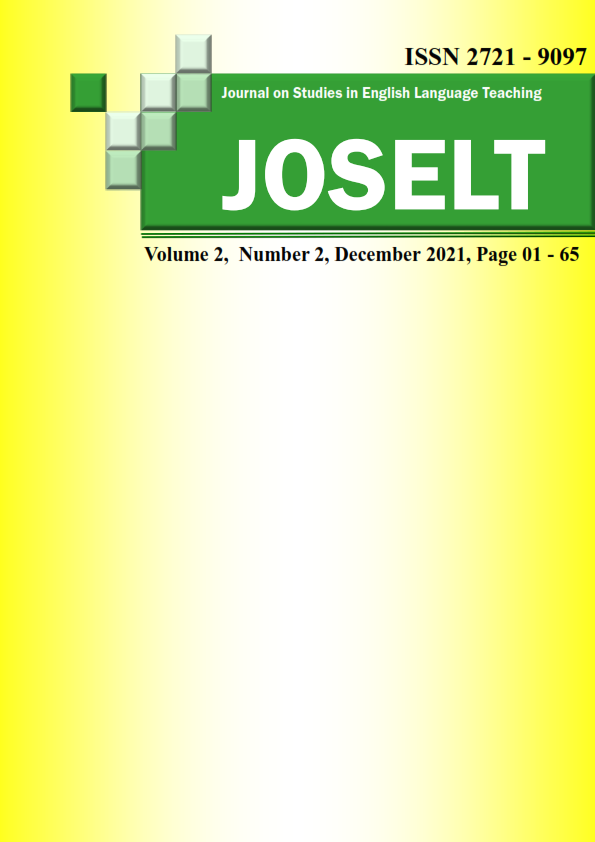IMPLICATION CBI TOWARDS ADULT LEARNERS’ BUSINESS ENGLISH CORRESPONDENCE SKILLS
Keywords:
writing skill, teaching strategy, CBI, competencyAbstract
Analysing the ability of the employees in business English correspondence seems challenging in edult learners teaching because it can encourage the psycholingusitic domain in bilingual learning. The present study attempted to find out whether the writing skill of the employees in Sukavathi villa in business English correspondences skills can be improved through content based instruction (CBI). The subject of the present study was 32 employees. The main characteristic of the study was an action reaseach with descriptive approach. Moreover, series of test and observation techniques were used to collect the data that were anaylised descriptively. The result revealed that the CBI impacted the students’ abilities in writing English formal and informal letters or E-mails for any business purposes. The mean score of the pre-test was 54.56 that is categorized poor. After the implementation of CBI, the achievement increased from 63.81 to 80.25, being categorized very good. Furthermore, the learning process with CBI showed that 10% of employee incolved low participation, 25% moderate partcipation, and 65% high participation. The study suggest that bililngual learning for adult learners requires affective encouragement, commitment, and stimulation towards the target language mastery
References
Adnyana. N.I. (2018). Improving Writing Skill of Tenth Grade Students of SMKN 4 Denpasar In Academic Year 2018/2019 Through Tell-Show Strategy. Denpasar: Unmas.
Brown, H. D. (2004). Language Assessment Principle and Classroom Practice. New York: Addison Wesley Logman.
Burns, A. (2010). Doing Action Research in English Language Teaching A Guide for Practitioners. New York & London Routledge.
Cohen, L., Manion, L., and Morrison, K. (2005) Research Methods in Edcation(5th ed). New York: Routledge.
Galko, F.D. (2001). Better writing Right. New York: Learning Express.
Gutamiasih.K.N. (2018). Improving Writing Skill of the Seventh Grade Students of SMP Sila Dharma Denpasar in Academic Year 2017/2018 through Tell-Show Strategy. Denpasar: Unmas.
Griffee, D.T. (2012). An Introduction to Second Language. Research Method. Alexandria: Library of Congress Cataloging-in-Publication Data.
Harmer, J. (2004). How to Teach Writing.Cambridge: Logman.New York: Logman.
Hayland, K. (2003). Second Language Writing. Hong Kong: Cambridge Language Education.
Marzano, R. J. (2006). Classroom Assessment & Grading That Work. Alexandria: Library of Congress Cataloging-in Publication Data.
McNiff. J and Whitehead, J. (2002) Action Research Principle and Practice (Second Edition). London: Routledge Falmer.
Mita.K.I. (2017). Improving Writing Skills Through Tell-show Strategy of The Eighth Grade Students of SMPN2 North Kuta in Academic Year 2016/2017. Denpasar: Unmas.
Oshima, A and Hogue, A. (2007). Introduction to Academic Writing Third Edition. New York: Logman.
Peha, S. (2010). The Writing Teacher’s Strategy Guide. North Carolina: Teaching That Makes Senses, Inc.
Richards, J. C., and Schmidt. R. (2002. Longman Dictionary of Language Teaching and Applied Linguistics (3rd ed). London: Pearson Education Limited.
Savage, A. and Mayer, P. (2005). Effective Academic Writing 2. New York: Oxford University Press.
Wallace, T., Stariha, W. E., and Walberg, H, J. (2004). Teaching Speaking, Listening, and Writing. Brussels: Belgium International Academy.
Weigle, S. C. (20020. Assessing Writing Cambridge Language Assessments Series. New York: Cambridge University Press.
Zemach, D. E. and Rumsiek, L. A. (2005). Academic writing from Paragraph to Essay. London: Macmillan Publisher.
Zemach, D. E. and Islam, C. (2005). Paragraph Writing: From Sentence to Paragraph. Oxford: Macmillan.

